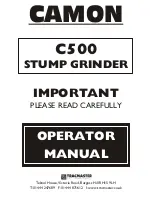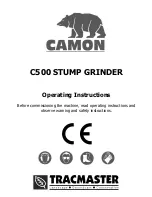
9
Operation
6. First disconnect the pneumatic grinder from the air supply when exchanging
the sanding pad, when not using the unit, after finished working and when
applying maintenance work. Press the trigger in order to remove any remain-
ing air from the pneumatic grinder.
Replacing the Shaft
Use the two supplied open-end spanners to replace
or to fix the shaft (2).
1. Disconnect the pneumatic grinder from the air
supply.
2. Arrange the open-end spanners as shown
accurately fitting to the shaft. Grab the small
spanner and turn the larger spanner counter
clockwise to loosen the shaft and turn it clock-
wise to tighten the shaft.
Air Pressure and Air Volume
Operate the pneumatic grinder with a pressure of 6.3 bar (90 psi) using a
compressor with an air suction capacity of at least 230 l/min. The ideal
capacity is provided by compressors with a suction capacity of
300 – 400 l/min.
Only use air hoses with an inner diameter of at least 9 mm. When setting up
the air pressure, always keep in mind that the pressure will decrease approx.
0.6 bar when using a 10 m long hose with an inner diameter of 9 mm.
Maintenance and Care
To ensure proper functionality and a long lifetime, diligent lubrication and
maintenance is essential.
For operating pneumatic tools clean air is required. Corrosion residues, dust
and dirt from the pneumatic pipes reduce the efficiency of the tool and will
cause technical problems. An upstream maintenance unit consisting of filter,
pressure regulator valve and lubricating equipment removes moisture and dirt
from the air, controls the working pressure and supplies the tool perfectly with
lubricating oil.
If necessary clean the unit with a moist cloth.
Do not use abrasive or aggressive chemicals as benzene or thinner, which
may dissolve plastic parts.





































